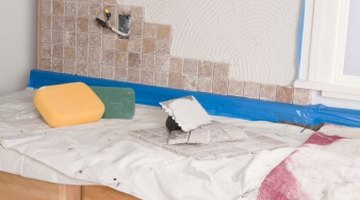How to Remove Polyurethane Finish From Cabinets
Home ownership brings a lot of pride until you are forced to look at the same interior design year after year. A kitchen tends to be the hub of activity for most homes, and replacing cabinets is a guaranteed way to bring back some excitement. This type of project often carries a shockingly high price tag.

An equally effective and less expensive method of updating the kitchen is to refinish the cabinetry. Before a beautiful new look can be applied, the old polyurethane finish has be removed.
Things You Will Need
- Screwdriver
- Masking tape
- Marker
- 2 plastic drop cloths
- Face mask
- Gloves
- Paint brush
- Gel stripping agent
- Putty knife
- Steel wool
- Toothbrush
- Cotton cloth
- Sander and 220-grit sandpaper
Tip
Remove all pets and small children from any area where you will be using a stripping agent. The fumes are very strong. Work in small sections to avoid the stripper evaporating before you are done. The stripper must still be liquid to work with.
Warning
Wear a mask and gloves to protect your lungs and skin from the harsh chemicals. Keep the area well ventilated and avoid open flames. Check with your municipality regarding the disposal of the stripping agent.
Preparation
-
Remove all doors, drawers, hinges, handles and knobs. Use a screwdriver to remove the screws, twisting in a counterclockwise direction. Use a marker and a small piece of masking tape to label each drawer and cabinet door with a designated symbol that indicates where they go when finished. Save all hardware and screws in a convenient location.
-
Place a drop cloth over the floor in a well-ventilated area you have picked to strip the polyurethane off the cabinets. Set all doors and drawers on the plastic in the order you wish to complete them.
-
Place a drop cloth over all counters directly beneath the cabinets you will be using the stripping agent on. Secure it in place using masking tape.
Stripping the Finish
-
Put on a face mask and protective gloves. Apply an even, thin layer of gel stripping agent to small areas of the finish on the cabinets using a paint brush. Wait a few minutes for the gel to begin working. The polyurethane finish will start to bubble up.
-
Hold the putty knife down toward the wood surface at a 45-degree angle. Begin carefully scraping the polyurethane and stripper from the wood. Scrape with the grain of the wood to avoid gouges.
-
Dip a steel wool pad and toothbrush in stripper to finish scrubbing away areas of polyurethane that seem to not want to budge. Allow the surface a few hours to dry.
-
Use a small belt or palm sander with 220-grit sandpaper to smooth the surface and remove all leftover stripper. Wipe the surface with a damp cotton cloth to remove any remaining dust.
The Drip Cap
- Home ownership brings a lot of pride until you are forced to look at the same interior design year after year.
- Remove all doors, drawers, hinges, handles and knobs.
- Place a drop cloth over the floor in a well-ventilated area you have picked to strip the polyurethane off the cabinets.
- Hold the putty knife down toward the wood surface at a 45-degree angle.
References
Photo Credits
- Jupiterimages/Comstock/Getty Images
- Jupiterimages/Comstock/Getty Images
More Articles



